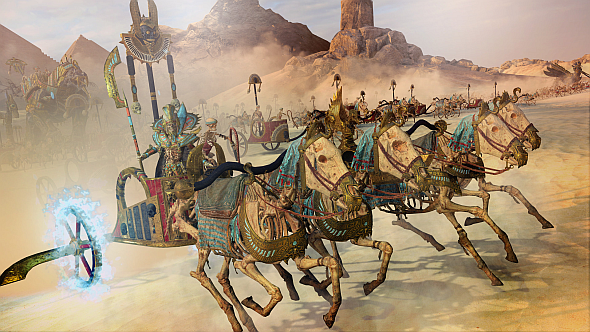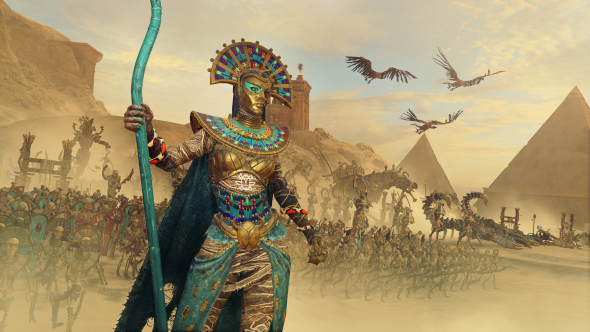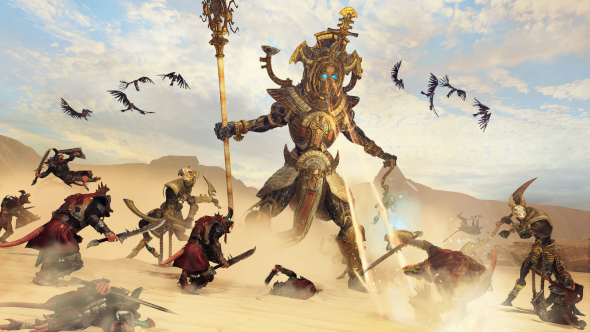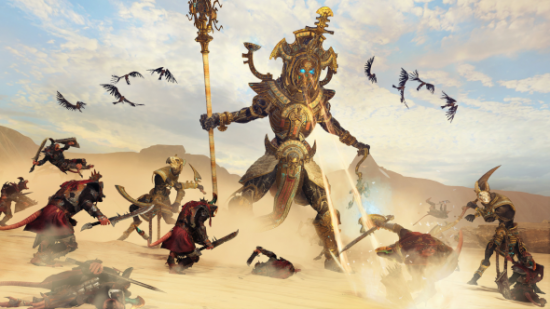Vampire Counts are so 2016. It’s a new year and there are new undead in town, rocking a hot new Egyptian look and bringing some seriously cool new units, including stone sphnixes, jackal-headed constructs with giant bows, and – oh yeah – a priest entombed in a giant statue that shoots lasers from its eyes. Read on for a full breakdown of the Tomb King army roster in Total War: Warhammer II.
For more on the Tomb Kings, check out our gameplay preview.
Tomb Kings Legendary Lords

Settra the Imperishable isto the Tomb Kings as Karl Franz is to the Empire: their most significant political and military leader and their ‘default’ Legendary Lord. He rules Khemri, Nehekhara’s de facto capital, and can unlock a huge chariot to ride around in. A ruthless conqueror and rampant megalomaniac in life, he famously told Nagash himself that “Settra does not serve – Settra rules!” thus winning many admirers through badassitude alone. He starts in the heart of Nehekhara with some Tomb Guard and a Warsphinx in his army.
Grand Hierophant Khatepwas the head of thepriests’ cult under Settra, who exiled him when he was resurrected as a gross mummy rather than an eternal youth, as he’d been led to expect. Accordingly, poor Khatep starts in Naggaroth, and to make matters worse he’s been stuck with a diplomatic penalty with all Dark Elves. No wonder his campaign is rated hard. On the bright side, he’s a powerful spellcaster, and starts with a Hierotitan.
Arkhan the Blackwas theright-hand man to that fellow Nagash, who is rather a big deal in the lore – he invented the magic of Necromancy and cast the super-spell that resurrected all of Nehekhara as the aforementioned gross mummies. Since chaps like Khatep had promised the Tomb Kings a rather nicer rebirth, Nagash – and, by association, Arkhan – are not popular among their compatriots. Arkhan starts near Nehekhara’s western coast with a big diplomatic penalty to Tomb Kings relations, though he is friendlier with the Vampires, and their corruption doesn’t affect his public order. He also gets a Tomb Scorpion.
High Queen Khalida, favoured by the Asp Goddess, was a Nehekharan queen who had some serious beef with the first-ever vampires. It seems she was angry enough to follow them across the World Pond, since she starts in Lustria, waging war on the Vampire Coast. She confers poison attacks on her own army, reflecting the Asp Goddess’s blessing, and all armies in her faction get +20% ammunition, reflecting her fondness for archers. She starts with units of Necropolis Knights and Sepulchral Stalkers.

Lords
- Tomb King (melee lord)
Heroes
- Tomb Prince (melee hero)
- Liche Priest (caster hero: can be fielded on foot or a skeletal steed, can use the Lore of Nehekhara)
- Necrotect (hybrid hero: buffs construct units)
Infantry
- Skeleton Warriors (sword infantry: no unit cap)
- Skeleton Spearmen (spear infantry: no unit cap)
- Skeleton Archers (missile infantry)
- Nehekhara Warriors (sword infantry: damage dealer, anti-infantry)
- Tomb Guard (sword infantry: armoured and shielded, anti-infantry)
- Tomb Guard with halberds (halberd infantry: anti-large, charge defence vs large)
Cavalry
- Skeleton Horsemen (fast spear cavalry: shielded, vanguard)
- Skeleton Horsemen Archers (missile cavalry: vanguard)
- Nehekhara Horsemen (melee cavalry: shielded, anti-infantry)
War Machines
- Skeleton Chariot (melee chariot: anti-infantry)
- Skeleton Archer Chariot (missile chariot: anti-infantry)
- Screaming Skull Catapult (catapult: anti-infantry, armour piercing missiles)
War Beasts
- Carrion (flying war beasts: vanguard)
Monsters
- Sepulchral Stalkers (monstrous infantry: armour piercing, anti-large, vanguard)
- Ushabti (monstrous infantry: armour piercing, anti-infantry)
- Ushabti with Great Bow (monstrous missile infantry: armour piercing missiles)
- Necropolis Knights (monstrous cavalry: armour piercing, poison)
- Necropolis Knights with halberds (monstrous cavalry: armour piercing, anti-large, poison)
- Tomb Scorpion (monster: armour piercing, anti-infantry, terror)
- Khemrian Warsphinx (monster: armour piercing, anti-infantry, terror)
- Necrosphinx (monster: armour piercing, anti-large, terror)
- Hierotitan (monster: spellcaster, armour piercing, terror)

Tomb King Strategies
Like the Vampire Counts, Tomb Kings are undead. This means they crumble rather than run whenever their leadership drops, which can make them an attritional pain in the neck to fight until your enemies can field strong anti-infantry. Press this advantage by bringing a spellcaster and unlocking Restless Dead for free heals whenever you cast magic, and don’t forget about the Realm of Souls. The fact your trash infantry doesn’t even have a unit cap means you can field a 20-stack army for no expense in the first few turns. Keep them healed, and you should be able to score some easy victories in the early game.
There are complications, though: you can’t field a second army until you unlock one through research, which should take you about 15 turns, so be wary of distant or overambitious campaigns. You also have no armour piercing until Ushabti and Sepulchral Stalkers at tier three, so stay away from Dwarfs until then.
The late-game brings an abundance of melee troops that can handle armour, infantry, and monsters, as well as an abundance of terror-causing creatures of your own. Ranged anti-large and flyers are notable weaknesses, though – Carrion are quick but weak, and Skull Catapults are for infantry only. Take care to only challenge enemy monsters with melee anti-large, and counter flyers with shooting.
Tomb Kings’ archery is passable, but your key advantages are in melee, where you have endurance, psychology, and a broad toolkit all on your side. Maximising these depends on keeping your characters alive and picking your battles, so be wary of anyone who can outmaneouvre or outshoot you – the latter is harder than the former, but plenty of armies can still manage it. Bretonnia and Wood Elves leap to mind. Anyone who can match you in melee and doesn’t scare easily will also be tricky, so take care around Chaos and Dwarfs.
